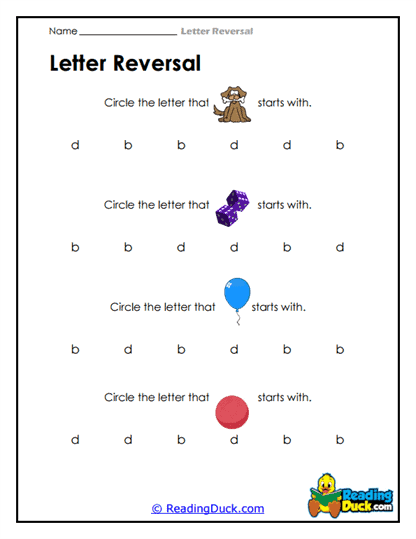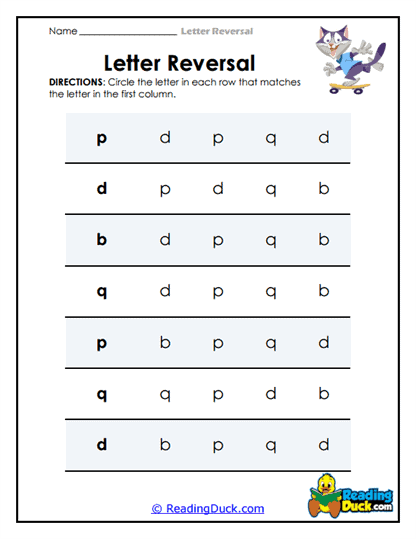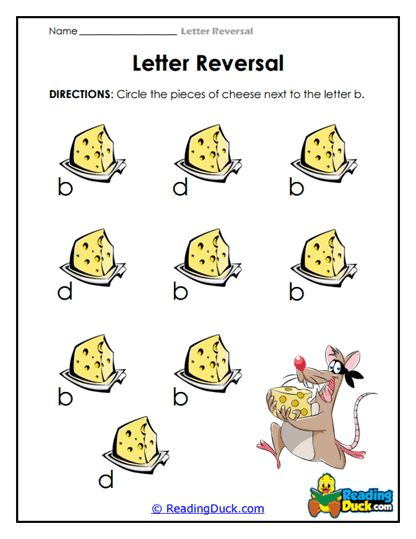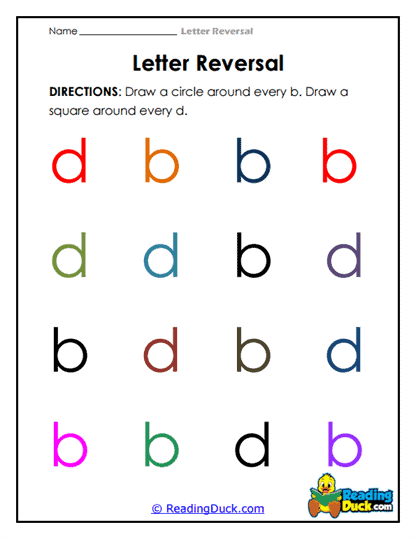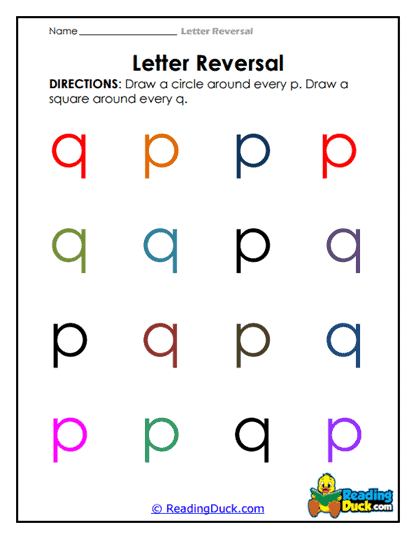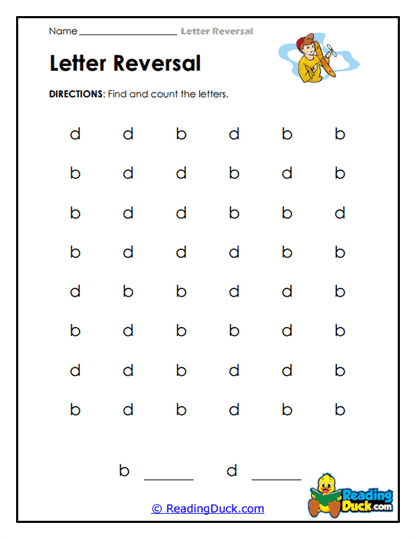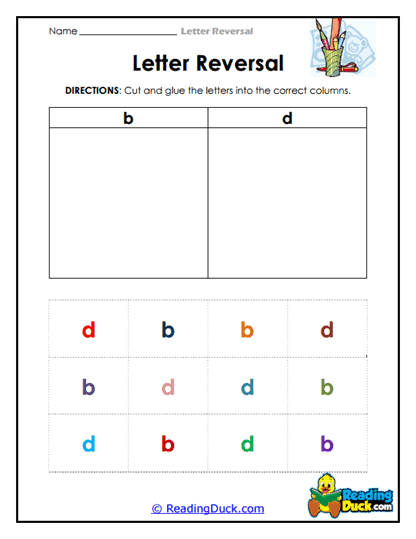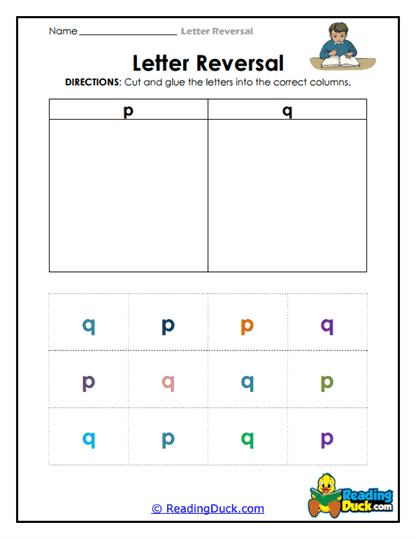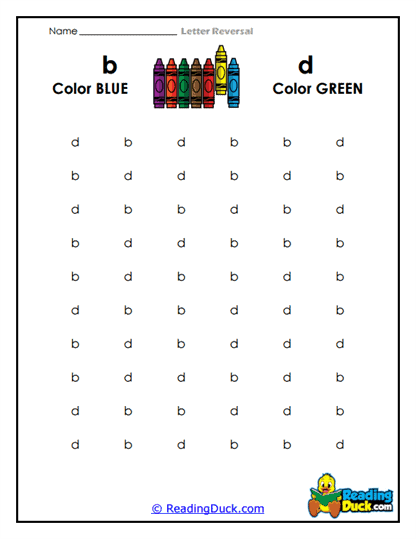Letter Reversal Worksheets
About Our Letter Reversal Worksheets
Our collection of Letter Reversal Worksheets is an invaluable resource within the 'Phonics' category of the 'Pre-Reading' section, specifically crafted to help young learners identify, correct, and overcome common letter reversals, such as confusing "b" with "d" or "p" with "q." These worksheets are designed to provide targeted practice to address this common challenge in early literacy development.
Available in a user-friendly PDF format, these worksheets are easy to view, download, and print, making them perfect for both classroom and homeschool use. Additionally, each worksheet comes with a downloadable answer key, enabling educators and parents to effectively guide students through their learning process and track their progress.
Understanding Letter Reversal and Its Impact on Early Literacy Development
Letter reversals are a common challenge among early learners, especially as they begin to develop their reading and writing skills. As a professional licensed teacher specializing in pre-reading skills, it is essential to explore what letter reversals are, why they occur, and how addressing them is crucial to a child’s literacy development.
What Are Letter Reversals?
- Definition: Letter reversals occur when children mistakenly write letters backward or confuse similar-looking letters, such as writing "b" instead of "d" or "p" instead of "q." This is often seen in early stages of writing, especially in kindergarten and first grade.
- Common Reversed Letters: The most frequently reversed letters include "b" and "d," "p" and "q," as well as "n" and "u." These reversals are typically due to the similar shapes of the letters, which can be difficult for young children to differentiate.
Why Do Letter Reversals Happen?
- Developmental Stage: Letter reversals are a normal part of early writing development and are typically seen in young children as they learn to recognize and write letters. This stage of development is characterized by ongoing refinement of motor skills and visual perception.
- Directionality Confusion: Children are still learning the concepts of left and right, which can contribute to difficulties with letter orientation. This confusion often leads to reversals, especially with letters that look similar when flipped.
- Visual Processing: Some children may experience challenges with visual processing, where they have difficulty distinguishing between similar shapes. This can contribute to consistent letter reversals in both reading and writing.
The Importance of Addressing Letter Reversals:
- Reading Fluency: Correcting letter reversals is important for reading fluency, as consistent errors can hinder a child’s ability to read smoothly and accurately. Misreading letters can lead to confusion and frustration during reading activities.
- Spelling and Writing Accuracy: In writing, reversing letters can lead to spelling errors and affect a child’s ability to communicate effectively. Addressing these issues early helps prevent bad habits from forming and supports accurate writing skills.
- Confidence in Literacy: As children overcome letter reversals, their confidence in their reading and writing abilities grows. This confidence is crucial for fostering a positive attitude toward learning and encouraging continued progress in literacy.
How These Worksheets Support the Correction and Practice of Letter Reversals
Our Letter Reversal Worksheets are specifically designed to help young learners recognize, correct, and practice overcoming letter reversals. These worksheets are an essential tool for guiding students through this common challenge and helping them build strong foundational literacy skills.
Targeted Practice for Common Reversals:
- Focused Learning: The worksheets focus on the most commonly reversed letters, such as "b" and "d" or "p" and "q," providing targeted practice to help students distinguish between these similar shapes. This focused approach helps students overcome specific challenges with letter orientation.
- Reinforcement of Correct Letter Formation: By providing consistent practice in writing and recognizing letters correctly, these worksheets reinforce the correct formation and orientation of letters. This reinforcement is essential for helping students internalize the correct patterns.
- Visual and Kinesthetic Learning: The worksheets incorporate visual aids, such as arrows indicating the correct direction of letter formation, or activities that involve tracing or writing letters repeatedly. These methods cater to different learning styles and help solidify the correct orientation of each letter.
Supporting Independent and Guided Practice:
- Self-Correcting Exercises: The worksheets are designed to encourage students to self-correct, allowing them to identify and fix their own mistakes. This promotes independent learning and helps students become more aware of their writing habits.
- Guided Instruction: In addition to independent practice, the worksheets can be used during guided instruction, where educators or parents provide immediate feedback and support. This combination of guided and independent practice helps ensure that students fully grasp the concept of letter orientation.
Strategies for Teaching Letter Reversals Effectively
Addressing letter reversals in young learners requires a strategic and supportive approach to ensure that students can overcome this challenge and build strong literacy skills. Here are some strategies that educators can use to effectively teach and correct letter reversals:
Introducing Letter Orientation:
- Start with Visual Comparisons: Begin by introducing commonly reversed letters side by side, such as "b" and "d" or "p" and "q." Use visual comparisons to highlight the differences in shape and direction, helping students see how the letters differ.
- Use Mnemonics and Visual Cues: Incorporate mnemonics or visual cues to help students remember the correct orientation of letters. For example, associate "b" with the word "bat" (a bat and then a ball) and "d" with "dog" (a dog's head and then its tail).
- Modeling and Guided Practice: Demonstrate how to correctly form letters through modeling. Use guided practice sessions where students can trace letters, write them in the air, or use manipulatives to reinforce the correct formation of each letter.
Helping Students Overcome Reversals:
- Frequent Practice: Ensure that students have frequent opportunities to practice writing and recognizing letters correctly. Incorporate activities that involve tracing, copying, and writing letters to reinforce proper orientation.
- Interactive and Engaging Activities: Use interactive and engaging activities, such as letter-matching games, to help students practice distinguishing between commonly reversed letters. This keeps learning fun while reinforcing key concepts.
- Positive Reinforcement: Provide positive reinforcement when students correctly identify or write letters. Celebrate their successes to build confidence and encourage continued progress in overcoming reversals.
Practical Tips for Using Letter Reversal Worksheets Effectively
To maximize the effectiveness of the Letter Reversal Worksheets, educators and parents can use the following practical tips to ensure that young learners develop the skills they need to overcome letter reversals and improve their literacy skills.
Incorporating Worksheets into Daily Practice:
- Morning Writing Exercises: Use the worksheets as part of a morning writing exercise to reinforce correct letter formation and orientation. Starting the day with this focused practice helps set a positive tone for the rest of the learning activities.
- Homework Assignments: Assign worksheets as homework to provide additional practice outside of the classroom. Encourage parents to review the worksheets with their children, offering guidance and support where needed.
- Small Group Work: Utilize the worksheets during small group work sessions for targeted instruction. This allows for personalized attention, where educators can address specific challenges faced by individual students.
Supplementary Activities to Support Learning:
- Tactile Learning Tools: Incorporate tactile learning tools, such as sandpaper letters, playdough, or letter stamps, to help students physically form the correct shapes of letters. This hands-on approach reinforces learning through multiple senses.
- Interactive Letter Games: Use interactive letter games that focus on correcting reversals, such as matching games or memory games that require students to differentiate between similar letters. These activities make learning engaging and reinforce proper letter orientation.
- Story and Sentence Writing: Encourage students to write stories or sentences using words that contain commonly reversed letters. This creative activity not only reinforces the correct letter orientation but also enhances writing skills and creativity.
Supporting Literacy Development with Letter Reversal Worksheets
In conclusion, our Letter Reversal Worksheets within the 'Phonics' category of the 'Pre-Reading' section are an essential resource for helping young learners address and overcome the common challenge of letter reversals. These worksheets are designed to provide targeted practice and support, enabling students to build strong foundational skills in reading and writing.
Overcoming letter reversals is a critical step in a child’s literacy journey. By mastering letter orientation, students gain the confidence and skills they need to read and write accurately, setting the stage for continued academic success. As students practice and internalize the correct formation of letters, they develop greater fluency in reading and writing, which is crucial for their overall educational growth.
Educators and parents can use these worksheets to create a positive and supportive learning environment that fosters both guided instruction and independent practice. By integrating these worksheets into daily lessons and supplementing them with interactive activities, students will not only overcome letter reversals but also develop a strong, lasting foundation in literacy.
These worksheets are particularly well-suited for kindergarten through second-grade learners and are an invaluable part of any early literacy program. They ensure that young readers develop the phonics skills and confidence needed to thrive in their reading and writing endeavors, helping them to succeed both in the classroom and beyond.
